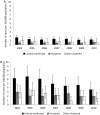The road to tuberculosis (Mycobacterium tuberculosis) elimination in Arkansas; a re-examination of risk groups
- PMID: 24618839
- PMCID: PMC3949677
- DOI: 10.1371/journal.pone.0090664
The road to tuberculosis (Mycobacterium tuberculosis) elimination in Arkansas; a re-examination of risk groups
Abstract
Objectives: This study was conducted to generate knowledge useful for developing public health interventions for more effective tuberculosis control in Arkansas.
Methods: The study population included 429 culture-confirmed reported cases (January 1, 2004-December 31, 2010). Mycobacterium tuberculosis genotyping data were used to identify cases likely due to recent transmission (clustered) versus reactivation (non-clustered). Poisson regression models estimated average decline rate in incidence over time and assessed the significance of differences between subpopulations. A multinomial logistic model examined differences between clustered and non-clustered incidence.
Results: A significant average annual percent decline was found for the overall incidence of culture-confirmed (9%; 95% CI: 5.5%, 16.9%), clustered (6%; 95% CI: 0.5%, 11.6%), and non-clustered tuberculosis cases (12%; 95% CI: 7.6%, 15.9%). However, declines varied among demographic groups. Significant declines in clustered incidence were only observed in males, non-Hispanic blacks, 65 years and older, and the rural population.
Conclusions: These findings suggest that the Arkansas tuberculosis control program must target both traditional and non-traditional risk groups for successful tuberculosis elimination. The present study also demonstrates that a thorough analysis of TB trends in different population subgroups of a given geographic region or state can lead to the identification of non-traditional risk factors for TB transmission. Similar studies in other low incidence populations would provide beneficial data for how to control and eventually eliminate TB in the U.S.
Conflict of interest statement
Figures




References
-
- Centers for Disease Control and Prevention (2010). Reported tuberculosis in the United States, 2010. Available: http://www.cdc.gov/tb/statistics/reports/2010/pdf/report2010.pdf. Accessed 25 August 2012.
-
- Centers for Disease Control and Prevention (2012) Trends in tuberculosis–United States, 2011. MMWR 61 (11) 181–5. - PubMed
-
- Taylor Z, Nolan CM, Blumberg HM (2005) American Thoracic Society, Centers for Disease Control and Prevention, (2005) et al. Controlling tuberculosis in the United States. Recommendations from the American Thoracic Society, CDC, and the Infectious Diseases Society of America. MMWR. Recommendations and reports: Morbidity and mortality weekly report. Recommendations and reports/Centers for Disease Control 54 (RR-12) 1–81. - PubMed
-
- Burzynski J, Schluger NW (2008) The epidemiology of tuberculosis in the United States. SeminRespirCrit Care Med 29 (5) 492–498. - PubMed
MeSH terms
LinkOut - more resources
Full Text Sources
Other Literature Sources
Medical

